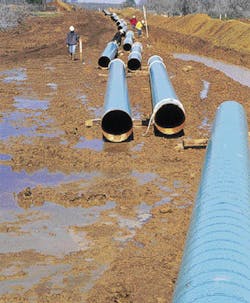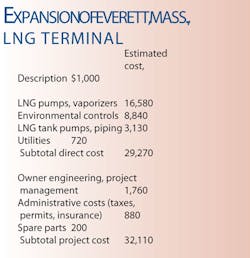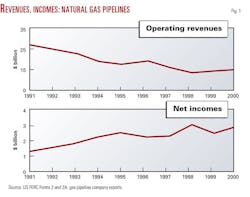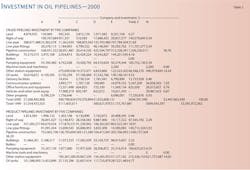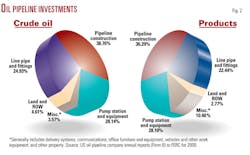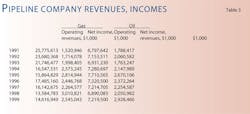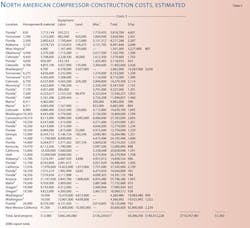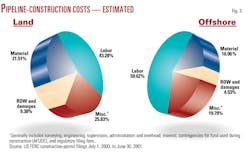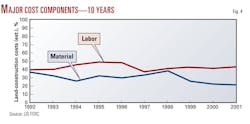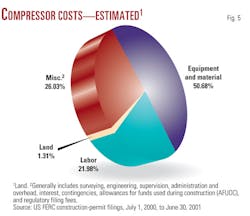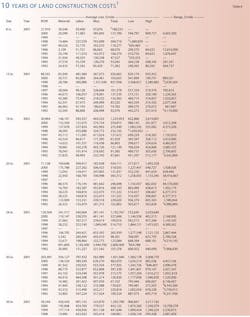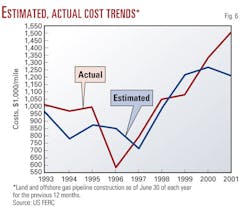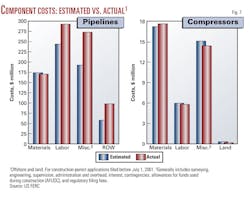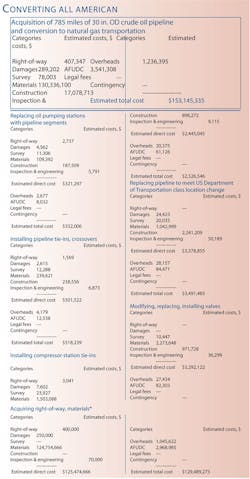Pipeline Economics: Profitable 2000, higher demand push US natural gas construction plans
Caught off guard by demand spikes and infrastructure squeezes in winter 2000-01, US natural gas interstate pipelines have increased plans for construction, according to applications filed before the US Federal Energy Regulatory Commission through June 30, 2001.
Mostly, companies want to add compression to their current systems, rather than build new stations, in an effort to deliver more gas as early as possible. Compressor-construction plans filed in the 12 months ending June 30 nearly doubled over such plans for the year-earlier period.
Bankrolling these plans are increased revenues and incomes for calendar year 2000, as revealed in annual reports filed with FERC.
Other filings with FERC reveal that, while actual costs of past compressor-station projects reported for the 12-month period through the end of June nearly matched those originally estimated, actual costs for pipeline installation showed a leap over original estimates for the second year in a row. Once again, higher labor costs fueled the jump.
US pipelines
Annual reports filed by US regulated interstate natural gas and common carrier oil pipelines to FERC for 2000 revealed these and other trends and, over time, permit analysis of these companies and their systems.
Two large tables (beginning on p. 81) offer a variety of data for US pipeline companies: revenue, income, volumes transported, miles operated, and investments in physical plants.
The table on natural gas companies has tracked how the US gas transmission industry has changed under lessening regulation. OGJ's exclusive, annual Pipeline Economics Report began tracking volumes of gas transported for a fee by major interstate pipelines for 1987 (OGJ, Nov. 28, 1988, p. 33) as pipelines moved gradually after 1984 from owning the gas they moved to mostly providing transportation services.
Additionally, the company tables have, for the past 3 years, indicated the asset consolidation and merger activity taking place in an effort to improve transportation efficiencies and increase bottom lines. The table of oil pipeline companies contains several new names and new companies, while other familiar names and companies have disappeared, especially over the 18 months before June 30.
Reporting changes
Comparing annual US petroleum and natural gas pipeline mileage must be done carefully.
For any calendar year, for example, how many companies are required to file reports with the FERC may vary, as some companies become jurisdictional, others are declared non-jurisdictional, and still others are merged or consolidated out of existence.
FERC's two-tier classification system for natural gas pipeline companies after 1984 further complicates comparisons (OGJ, Nov. 25, 1985, p. 55).
Definitions of the categories can be found at the end of the company table for gas pipeline companies and in FERC Accounting and Reporting Requirements for Natural Gas Companies, para. 20.011.
Only major US gas pipelines are required to file miles operated in a given year. The other companies ("non-major") may indicate miles operated but are not specifically required to do so.
For several years after 1984, many non-majors did not describe their systems. But over time, filing descriptions of their systems has become more common, and most have been providing miles operated.
Reports for 2000 show a rise in FERC-defined major gas pipeline companies to 61 of 114, from 57 major companies among 114 filing for 1999.
FERC made an additional change to reporting requirements for 1995 for oil pipelines, which includes crude oil and petroleum products.
Exempt from requirements to prepare and file a Form 6 were those pipelines whose operating revenues have been at or less than $350,000 for each of the 3 preceding calendar years.
These companies must now file only an "Annual Cost of Service Based Analysis Schedule," which provides only total annual cost of service, actual operating revenues, and total throughput in both deliveries and barrel-miles.
Whether FERC designates an oil pipeline company an interstate common-carrier pipeline determines whether the company must file an annual report.
More changes came for 1996: Major natural gas pipeline companies were no longer required to report miles of gathering and storage systems separately from transmission.
Thus, total miles operated for gas pipelines consist almost entirely of transmission mileage. To continue to convey a 10-year trend, Table 1 has been adjusted to reflect only transmission mileage operated since 1991.
Deliveries
For 2000, gas pipelines gathered and moved almost 31.9 tcf of other companies' gas and sold slightly less than 800 bcf from their own systems. The gas transported for a fee represented a nearly 5% increase over volumes moved in 1999; the gas sold, a 7.6% drop over volumes sold a year earlier.
Oil pipelines moved more than 8% more in 2000 than in 1999 with an overall increase of more than 1.1 billion bbl of crude oil and product delivered.
Product deliveries in 2000 jumped by more than 1.7 billion bbl (30.5%). This continues an increase seen for 1999 after 3 years of falling deliveries of product.
Prices for motor gasoline, higher since the second half of 1999 and expected to go even higher this summer, had actually fallen somewhat by mid-summer. But August saw prices begin to hold as the Organization of Petroleum Exporting Countries announced plans to reduce crude oil exports by about 1 million bbl.
US crude oil shipments (slightly less than 50% of total oil movements) actually declined in 2000, by more than 8%.
Trunkline-traffic (1 bbl moving 1 mile = 1 bbl-mile) for US crude oil and product pipelines declined over traffic for 1999. Total barrel-mile movements decreased by more than 6%.
Rankings
FERC annual reports provide data to rank the top 10 US oil and gas pipeline companies. (See accompanying boxes.)
Companies' positions in these rankings shift year to year, with some dropping out and others dropping in, and reflect normal fluctuations in companies' activities and fortunes. Because these companies comprise such a large portion of their respective groups, however, the listings provide snapshots of overall industry trends and events.
Company financial data for all companies, not only majors in both types of pipeline service, provide a view of the ongoing condition of these industries (Fig. 1; Table 3).
A measure of company performance and health is provided by a calculation of return on investment: net income as a portion of gas-plant investment. The term "gas plant" refers to the physical facilities used to move natural gas: compressors, metering stations, and pipelines.
An overall downward trend since 1995 was bucked in 2000: more than 4.2%, compared with 3.8% in 1999; in 1998, it was 4.7%; in 1997, 3.8%; 1996, slightly more than 4%; 1995, 4.9%.
For the 1990s, this indicator of companies' healths has risen steadily. In 1984, it stood at 8.7%-the year the FERC began (with Order 436) restructuring the interstate gas pipeline industry, culminating in 1992 with Order 636.
Beginning with 1985, net income as a portion of gas-plant investment fell precipitously through 1987 then began a gradual comeback.
All gas pipeline companies (majors and non-majors in 2000) reported an industry gas-plant investment totaling more than $68 billion, up from nearly $65.9 billion in 1999, more than $63 billion in 1998, and $59.8 billion in 1997.
In 2000, for oil pipeline companies, net income as a percentage of investment in carrier property rose to more than 9% from more than 8.6% in 1999, which had reversed a 2-year decline: 6.8% in 1998 and 7.3% in 1997.
Actual investment in carrier property fell more than 12% in 2000, by more than $4 billion to $29.6 billion, bucking an overall upward trend since 1990 and reaching the lowest level since 1996 ($28 billion).
Carrier property had increased in 1999 to more than $33.8 billion from $30.1 billion in 1998 and $30.6 billion in 1997.
Oil & Gas Journal for several years has tracked carrier-property investment by five crude oil pipeline and five products pipeline companies chosen as representative in terms of physical systems and expenditures (Table 2).
For 2000, the pattern was mixed: The five crude oil pipeline companies actually reduced their overall investment in carrier property by nearly 4% over that for 1999, while the five products pipeline companies increased theirs, by almost 5%.
The trend in the 1990s had been steadily higher: $2.3 billion for 1997, $2.1 billion in 1996, $2 billion for 1995, and $1.97 billion for 1994.
But in 1998, a major crude oil pipeline company that had been part of this list merged with two other large pipeline companies. Comparisons with earlier years must, therefore, be qualified.
In 2000, investment by the five product pipeline companies was more than $4.2 billion, continuing a trend evident for much of the 1990s: barely more than $4 billion in 1999, nearly $3.8 billion in 1998; slightly less than $3.7 billion in 1997; $3.6 billion in 1996; $3.5 billion in 1995; and $3.3 billion in 1994.
Fig. 2 illustrates the investment split in the crude oil and products pipeline companies.
Another measure of the profitability of oil and natural gas pipeline companies in recent years is the portion net income represents of operating income (Table 3).
For oil pipelines, the percentage of income in operating revenues had been hovering in the mid-20s for the first 5 years of the 1990s; for the last 6 years, however, it pushed into the 30s, reaching more than 36% in 2000.
Construction
US interstate natural gas pipeline companies must apply for a "certificate of public convenience and necessity" from FERC to modify facilities (adding pipe or compression or abandoning, selling, or removing it).
Most of these applications must contain estimates of what such modifications will cost; some types of applications are, however, exempt from providing costs estimates.
Annual tracking of the mileage and compression horsepower applied for and of the estimated costs indicates future construction. And Oil & Gas Journal has been doing that since this report began more than 40 years ago.
Tables 4 and 5 show companies' estimates during the period from July 1, 2000, to June 30, 2001, for what it will cost to construct a pipeline or install new or additional compression.
Those tables cover a variety of locations, pipeline sizes, and compressor-horsepower ratings.
Rush to supply
For any period, not all projects that are proposed are approved; not all approved ones are eventually built. OGJ's twice-yearly construction survey tracks those that proceed.
Applications filed in the 12 months ending June 30, 2001, suggest the immediate future of gas-pipeline construction on US interstate system:
- More than 1,100 miles of pipeline were proposed, all for land construction. This compares with nearly 1,500 miles of land pipeline plus another 1,000 miles for offshore propsed for the 12 months before June 30, 2000 (Table 4).
- Nearly 514,000 hp of new or additional compression was applied for compared with more than 254,000 hp for the same period the year before (Table 5). (All applications are for land-based compression.)
And in those compression projects lies the most significant story in this year's report:
- The number of compression projects for the period ending June 30, 2001, more than doubles the number applied for in the previous 12 months.
- Of the total amount of compression to be built, nearly 64% (more than 327,000 hp) is for added capacity at existing stations.
The significance of this latter point is that companies clearly feel they stand a much greater chance of meeting expected higher gas demand early if they expand existing compression capacity. And much of this added compression is linked to pipeline looping of existing systems, also easier and quicker to get approved than new pipeline over virgin right-of-way.
- Finally, most of the compression-new and additional-is aimed at the two markets witnessing the largest demand growth, especially in the last 12-18 months: California and Florida.
Table 4 lists 49 land-pipeline construction "spreads," or mileage segments, and 2 marine projects, compared with:
- 115 land and 6 marine projects (OGJ, Sept. 4, 2000, p. 68).
- 39 land and no marine projects (OGJ, Aug. 23, 1999, p. 45).
- 34 land and 2 marine projects (OGJ, Aug. 31, 1998, p. 33).
- 35 land and 4 marine projects (OGJ, Aug. 4, 1997, p. 37).
- 62 land and 2 marine projects (OGJ, Nov. 25, 1996, p. 39).
- 66 land and 3 marine projects (OGJ, Nov. 27, 1995, p. 39).
The 2000 report and the ones in 1999 and 1996 covered only US applications; the others included data from Canada.
For the 12 months ending June 30, 2001, the 51 projects would cost more than $1.5 billion.
Projects' cost projections indicate much about where companies believe unit construction costs ($/mile) are headed. These cost-per-mile figures indeed reveal more about cost trends than do aggregate totals.
For proposed US gas-pipeline projects in the 2000-01 period surveyed, the average land cost per mile was slightly more than $1.3 million/mile; for the offshore projects, more than $2.5 million.
For the 1999-2000 period, the land pipeline projects' costs averaged slightly more than $1.5 million/mile; for 1998-99, slightly more than $1.1 million/mile.
Components
Variations year-to-year in the four major categories of pipeline construction costs-material, labor, miscellaneous, and right-of-way (ROW)-can also suggest trends within each group.
Materials can include line pipe, pipe coating, and cathodic protection.
"Miscellaneous" costs generally cover surveying, engineering, supervision, contingencies, telecommunications equipment, freight, taxes, allowances for funds used during construction (AFUDC), administration and overheads, and regulatory filing fees.
ROW costs include obtaining right of way and allowing for damages.
For the 49 land spreads surveyed for the 2000-01 period covered here, costs-per-mile for the four categories were as follows:
- Material-$279,565/mile.
- Labor-$571,719/mile.
- Miscellaneous-$344,273/mile.
- ROW and damages-$120,607/mile.
For the 2 offshore spreads for the same period, costs-per-mile for the four categories were as follows:
*Material-$413,995/mile.
*Labor-$1,537,249/mile.
*Miscellaneous-$510,271/mile.
*ROW and damages-$116,898/mile.
Table 4 lists proposed pipelines in order of increasing size (OD) and increasing lengths within each size.
The average cost per mile for the projects shows few clear-cut trends related to either length or geographic area.
In general, however, the cost per mile within a given diameter indicates that the longer the pipeline, the lower the unit cost for construction. And, lines built nearer populated areas tend to have higher unit (per-mile) costs.
Additionally, road, highway, river, or channel crossings and marshy or rocky terrain each strongly affects pipeline construction costs.
Fig. 3, derived from Table 4, shows the major cost-component splits for land and offshore pipeline construction costs.
Material and labor for constructing land pipelines make up nearly 65% of the cost; for offshore lines, nearly 67%. Fig. 4 plots a 10-year comparison of land-construction unit costs for the two major components, material and labor.
Fig. 5 shows the cost split for land compressor stations based on data in Table 5.
Table 6 lists 10 years of unit ($/mile) land-construction costs for natural gas pipelines with diameters ranging from 8 to 36 in. The table's data consist of estimated costs filed under CP dockets with the FERC, the same data shown in Tables 4 and 5, with some data during occasional years provided by Canada's National Energy Board.
The average cost per mile for any given diameter, Table 6 shows, may fluctuate from one year to another as projects' costs are affected by geographic location, terrain, population density, or other factors.
Completed projects' costs
An operating company must file with FERC what it has actually spent on an approved and built project. This filing must occur within 6 months after the pipeline's successful hydrostatic testing or the compressor's being placed in service.
Shown in Fig. 6 are 9 years of estimated vs. actual costs on cost-per-mile bases for project totals.
Tables 7 and 8 show such actual costs for pipeline and compressor projects reported to the FERC during the 12 months ending June 30, 2001. Fig. 7, for the same period, depicts how total actual costs for each category compared to estimated costs.
Some of these projects may have been proposed and even approved much earlier than the 1-year survey period. Others may have been filed for, approved, and built during the survey period.
If a project was reported in construction spreads in its initial filing, that's how projects are broken out in Table 4.
Completed-projects' cost data, however, are usually reported to the FERC for an entire filing, usually but not always separating pipeline from compressor-station (or metering site) costs and lumping several diameters together.
Overall, estimated gas pipeline construction costs exceeded actual ones by nearly $183 million; the figures are for land construction, as no offshore construction costs were reported during the survey period.
Table 8 shows that actual costs for installing compression nearly hit the estimated ones exactly.
Click here to view US pipeline costs, estimated (table 4)
This survey is in PDF format and will open in a new window
Click here to view North American compressor-construction costs, estimated (table 5)
This survey is in PDF format and will open in a new window
Click here to view 10 years of land construction costs (table 6)
This survey is in PDF format and will open in a new window
Click here to view US pipeline costs: Estimated vs. Actual, 2000-2001 (table 7)
This survey is in PDF format and will open in a new window
